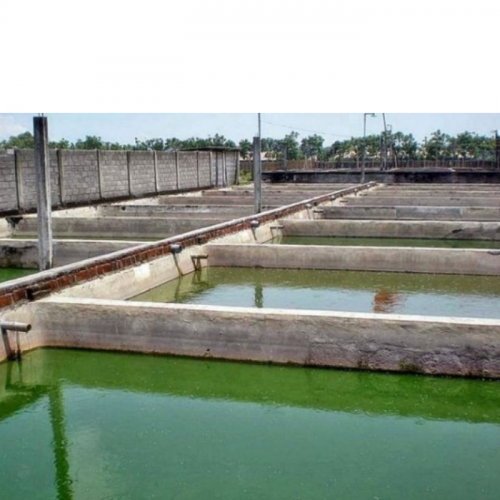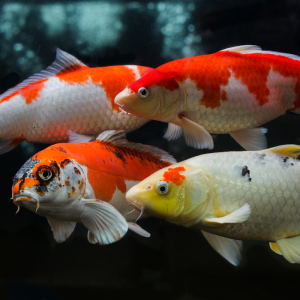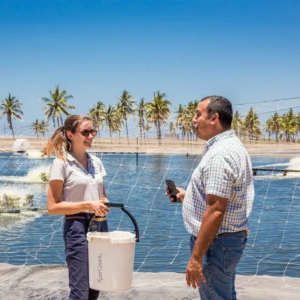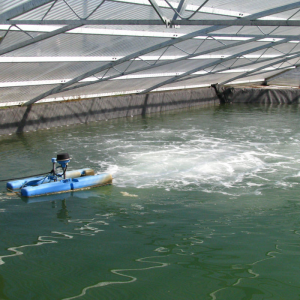
Ozone, How Do I Apply It?
| Fri, 22 Jan 2021 - 16:32
As a continuation of a previous column on ozonation, in this article we will cover different methods of applying ozone to a filtration system.
The original column, titled Ozone – Go Zone or No Zone, was published in Aquaculture Magazine 45-2 (AprilMay 2019). In that column, the different methods of making ozone were discussed.
What do we do with the ozone once it has been made? The possibilities are endless! The effectiveness of ozone correlates directly with the amount of ozone over a period of contact time, usually expressed as mg/L x CT. An example is 1mg/L for 2 minutes contact time. This column will discuss some of the most common options for ozone contact and injection.
Diffusers in an Open Top Tank
When I first started seeing ozone applied, it was in Central America at several of the shrimp farms we were working with at the time.
In most cases, the ozone was generated and applied directly to the incoming water basins via air diffusers. While this method will work, it also has a few considerations.
The most important consideration is that the ozone is off-gassing directly to the atmosphere and generally in a semi-closed building. This presents both a health hazard and additional wear and tear on the building since ozone is extremely caustic.
This is one of the most inexpensive ways to add ozone to a system is through diffusers, such as ultra-fine pore ceramic diffusers, glass bonded silica diffusers or other types.
This is true only because the diffusers themselves are inexpensive. However, in terms of efficiency, this can be one of the least effective ways to add ozone to a system since the gas is no longer pressurized once it leaves the diffuser. This is not something that is recommended unless there are no other options, and the proper precautions are taken.
From a health hazard point of view, the inhalation of ozone gas will cause irritation to the lungs and throat. It can exacerbate conditions such as asthma, COPD, and other lung-related illnesses.
In high enough doses, it can cause death. Frankly, ozone released into the atmosphere is not something to take lightly since it can cause long term damage to anyone in contact with it.
There are some ozone resistant materials which are recommended for use with ozone in the gaseous form. Most building materials are not on that list which means that any ozone gas released to atmosphere will corrode traditional building materials.
Venturi with a Pressurized Contact Tank
This is one of the most common ways that ozone is applied in filtrations systems.
A venturi is generally an injection molded part that is a short tube with a tapering constriction in the center that causes an increase in the velocity of flow of water and a corresponding decrease in pressure which is used to create suction.
The ozone source is attached to the suction fitting while the filtered water passes through.

Once the ozone is injected into the piping, the water enters a pressurized tank where it mixes for the allotted contact time.
In most applications, the contact time is set to 2 minutes. For a filtered flow rate of 500 gallons per minute, the contact vessel would be at least 1000 gallons.
There are many options for the materials that are used to make these tanks including stainless steel, epoxy-coated steel, and fiberglass.
Different manufacturers have customized the internal fittings for these tanks in the hopes that varying flow patterns will encourage better mixing.
We have not seen any discernable differences between manufacturers contact tanks. It really is a function of dosage and contact time.
These pressurized tanks are fitted with an off-gassing valve which allows the leftover gas to be removed from the system. Those off-gassing valves are plumbed to an ozone destruct to avoid sending ozone gas into the atmosphere.
Venturi and Protein Skimmers
Most, if not all, commercial protein skimmers use a venturi to introduce air and/or ozone.
The concept of using ozone with protein skimmers was developed to help encourage more efficient micro flocculation.
This only happens when very low levels of ozone are used (0.01mg/L). This dosage is not concentrated enough to disinfect.
In rare cases, some users have turned their protein skimmers into contact tanks for disinfection which is not the most efficient.
Venturi with a Speece Cone
This method is not as widely used but does have merit. It uses the venturi to introduce the ozone into the cone vessel.
Speece cones are built based on a design developed by Dr. Richard Speece from Vanderbilt University.
Basically, the inverted cone allows the velocity of the water to reduce while the undissolved gas rises.
As the water travels downward, it shears the gas bubble which keeps the ozone in suspension. Since the entire reaction is done under pressure, supersaturation can occur which can reduce the contact time.
These systems also do not require an off-gassing valve or ozone gas destruction as the entire volume of gas is dissolved into a solution.

Speece cones are more commonly used for introducing oxygen but are also a good option to use with ozone. The best part is that the end product of ozone breaking down is oxygen so it can perform a dual purpose of disinfecting and oxygenating.
These are only a few options for introducing ozone into a filtration system.
Please reach out to an appropriate engineer or designer when adding ozone to any filtration system to avoid inefficiencies and dangerous situations






















